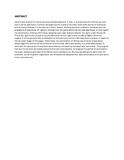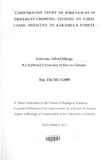Location
Our Vision is to be a world-class university committed to scholarly excellence.
Our Mission is to provide quality university education and training and to embody the aspirations of the Kenyan people and the global community through creation, preservation, integration, transmission and utilization of knowledge.
Core Values
In order to realize the above vision and mission, certain shared values shall be nurtured. There is great need for the University to be guided by the right values derived from the virtues and moral standards of the Kenyan and wider society.
Core Functions
Teaching and Learning: The university offers innovative , relevant and market driven academic programmes , both at undergraduate and postgraduate levels with inbuilt quality control systems the university also provides an environment and policy framework for undertaking high quality and relevant research
Members:
Resources
Displaying 121 - 125 of 298Regulation of the procedure for acquiring land as a Tool for monitoring land use to attain sustainable Development: A critique
Land is very central for human survival and development. In fact, it is so elemental to human
survival that it can be said that it is where life begins and it is where life ends. Land is the source
of livelihood and to many a Kenyan it is the source of food, shelter, clothing and even medicine.
Consequently the procedure of acquisition of rights or interest over the same cannot be any less
significant.
In that regard the Constitution of Kenya 2010 does recognize such right and provides for the
Abundance And Diversity Of Soil Mites (acari) Along A Gradient Of Land Use Types In Taita Taveta, Kenya
The abundance and diversity of soil mites was monitored along a gradient of land use types (LUTs) during the wet seasons in soils of Taita Taveta, Kenya. Sampling of mites from soils was carried out in eight LUTs which included maize-based system (Zea mays), coffee (Coffea Arabica), horticulture, napier grass (Pennisetum purpureum), fallow, pine (Pinus patula), cypress (Cypressus lusitanica), natural forest.
Land cover change under unplanned human settlements: A study of the Chyulu Hills squatters, Kenya
Land cover change under unplanned human settlements: A study of the Chyulu Hills squatters, Kenya
Comparative study of bird guilds in different cropping systems on farm lands adjacent to Kakamega forest
Tropical rainforests are characterized by habitat stability and complexity. Hence, the forests
support a rich biological diversity, including 40% of all bird species. However, these rain
forests have been shrinking due to increasing rate of deforestation, fragmentation, and other
forms of resource exploitation. Degradation and loss of rainforests has threatened their rich
biological diversity and the life-support systems. However, the rate at which birds are
displaced by forest clearing and the potential for birds' conservation on farmlands are not
Impact of land use and cover change on soil quality and pasture productivity in semi-arid rangelands
The impact of land use and cover change on soil quality and pasture production was investigated
in the rangelands of Nakasongola District, Uganda, Landsat (TM) images of 1986 and 1990 and
Landsat (ETM+) of 2000 and 2004 for Nakasongola District were used to determine the extent
and patterns of land use and cover change using the Integrated Land and Water Information
Systems (ILWIS) 3.6 software. A modified-Whittaker sampling design was used to collect soil
and pasture samples in three land cover types (bare, herbaceous and woody) under three





